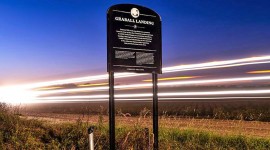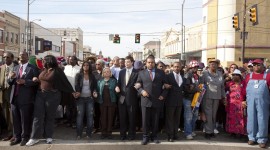The Civil Rights Movement
The ten-year period from 1954 to 1964 saw some of the most significant developments in Civil Rights history and is defined by the NPS as the Modern Civil Rights Movement. This includes the signing in 1957 by President Dwight D. Eisenhower of the first civil rights bill since Reconstruction, creating the independent U.S. Commission on Civil Rights, along with the 1954 U.S. Supreme Court decision in Brown v. Board of Education (mentioned below) and the 1964 Civil Rights Act (also mentioned below). Parks, streets, and other public open spaces served as the staging grounds for some of the movement’s most critical demonstrations and peaceful protests, including the Birmingham Campaign (1963), and the March on Washington for Jobs and Freedom (1963). This period had a profound impact on the southern urban landscape that survives to this day.
As crucial and impactful as the period from 1954 to 1964 was, numerous consequential events took place before and after that decade-long time that aimed to grant African Americans equal rights under the law and to end racial segregation and exclusion.
The struggle to end chattel slavery and racial inequities began in the 1730s with a Quaker-led abolitionist movement. Decades later, the words of Thomas Jefferson in the Declaration of Independence asserting that “all men are created equal” were adopted by abolitionists to condemn the institution of slavery and continued to do so leading up to the Civil War.
Passed during Reconstruction, the Thirteenth (ratified 1865), Fourteenth (ratified 1868), and Fifteenth (ratified in 1870) Amendments to the U.S. Constitution abolished slavery, guaranteed equal protection under the law and due process, and gave all male American citizens the right to vote regardless of their “race, color, or previous condition of servitude.” However, the U.S. Supreme Court ruling in Plessy v. Ferguson (1896) derailed that progress by permitting racial segregation of public spaces as long as they were equal to the facilities for whites, the doctrine known as “separate but equal.”
In 1941, President Franklin D. Roosevelt issued Executive Order 8802 prohibiting discrimination in the defense industry. It was spurred by a meeting between First Lady Eleanor Roosevelt, cabinet members, A. Philip Randolph, president of the Brotherhood of Sleeping Car Porters, and other African American leaders who threatened to bring tens of thousands of protestors to the White House unless their demands were met. The movement demonstrated the effectiveness of grassroots African American politics and that an African American-led mass movement of nonviolent protest could mobilize for civil rights. Seven years later, in July 1948, President Harry S. Truman, issued Executive Order 9981 desegregating the U.S. Armed Forces. (“During World War II, the Army had become the nation’s largest minority employer.”)
<<<Back to the Guide to African American Cultural Landscapes










